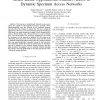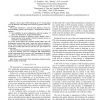GLOBECOM
2009
IEEE
14 years 6 months ago
2009
IEEE
Abstract—We propose a model-based channel access mechanism for cognitive radio-enabled secondary network, which opportunistically uses the channel of an unslotted primary network...
GLOBECOM
2009
IEEE
14 years 6 months ago
2009
IEEE
—This paper studies the tradeoff between channel coding and ARQ (automatic repeat request) in Rayleigh blockfading channels. A heavily coded system corresponds to a low transmiss...
GLOBECOM
2009
IEEE
14 years 6 months ago
2009
IEEE
—Significant research has been done on recognizing the daily activities using acceleration data but few works have focused on classifying the movements comprising an activity du...
GLOBECOM
2009
IEEE
14 years 6 months ago
2009
IEEE
— It was shown by Cadambe and Jafar that the interference alignment (IA) algorithm achieves the theoretical bound on degrees of freedom (DOF) for interference channel systems. Ho...
GLOBECOM
2009
IEEE
14 years 6 months ago
2009
IEEE
— The problem of resource allocation (RA) in a downlink OFDMA system with minimum user rate requests is examined under the realistic scenario of partial (imperfect) channel state...
GLOBECOM
2009
IEEE
14 years 6 months ago
2009
IEEE
—A multiple antenna multihop relay network consisting of a source, a relay, and a destination node, is considered. The diversity-multiplexing-delay tradeoffs (DMDT) for various m...
GLOBECOM
2009
IEEE
14 years 6 months ago
2009
IEEE
— Peer-to-peer (P2P) technology for TV broadcasting over the Internet is becoming more and more popular in the very last years. This paper introduces a network-wide efficiency m...
GLOBECOM
2009
IEEE
14 years 6 months ago
2009
IEEE
Abstract— We consider the Gaussian multiple-input multipleoutput (MIMO) multi-receiver wiretap channel, and derive the secrecy capacity region of this channel for the most genera...
GLOBECOM
2009
IEEE
14 years 6 months ago
2009
IEEE
—The Physical Layer of the IEEE 802.11 standard family provides a set of different modulation and coding schemes and, thus, a multitude of data rates. However, the Standard itsel...
GLOBECOM
2009
IEEE
14 years 6 months ago
2009
IEEE
— This paper studies an auction based allocation of network resources for short-term contracts for heterogeneous network services. The combinatorial winner selection yields the o...


